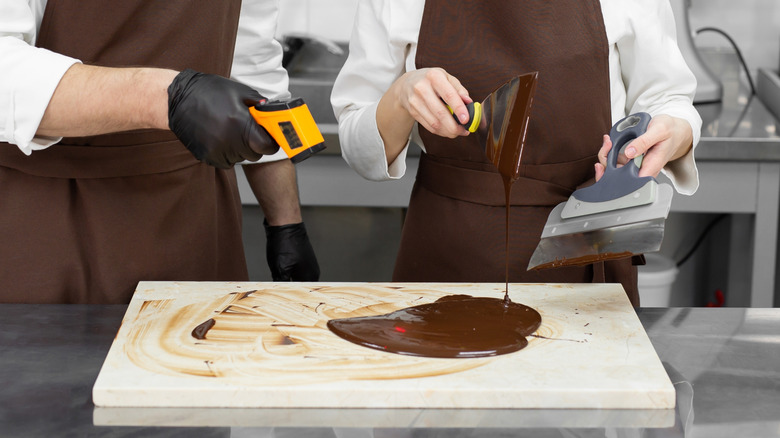This Key Tool Is The Secret To Perfectly Tempered Chocolate
We may receive a commission on purchases made from links.
For the average person, chocolate represents pure indulgence and, in the case of artisanal varieties, a hefty price tag. But for pastry chefs and chocolatiers? They're some of the most challenging, finicky ingredients one could ever work with. The bean-to-bar process — turning raw cocoa beans into proper chocolate bars — is notoriously difficult and time-consuming. But a level above that in difficulty is tempering, where the chocolate is cooled, then heated to an extremely precise temperature until it turns smooth, glossy, and can be snapped cleanly. This process is so precise, in fact, that without the aid of a good kitchen thermometer, it's almost guaranteed that you're going to end up with a dull, blotchy pot of chocolate that simply refuses to set properly.
You see, if you're new to chocolate tempering, the margin between success and failure is much thinner than you might expect. Just one or two degrees Fahrenheit can completely transform your chocolate's outcome (we'll explain why later). A thermometer will let you keep an eye on the temperature of the chocolate at all times, so you know how to adjust the heat when needed. Sure, it's not impossible to temper chocolate without one, but if you don't want to avoid a mess in your kitchen (or you're just starting out), trust us when we say that it's your best bet toward getting that perfectly tempered chocolate you've been dreaming of.
The role of temperature in chocolate tempering
Temperature plays a critical role in the tempering process. By repeatedly cooling and heating the chocolate, we can force the fats in it to crystallize into one of six forms. Some, like Forms I and II, are mushy and melt easily. Others, like Form V (known as "beta crystals"), can turn your chocolate glossy, smoothen out the texture, and keep the chocolate solid at room temperature — exactly what we're aiming for.
The first step is melting down your chocolate completely and "seeding" it with tempered chocolate bits to encourage crystallization. Once you do, you'll have to cool the batch down to around 81 degrees Fahrenheit. This is the best temperature for crystallization, and is where your thermometer will first come in handy to help you monitor the cooling step.
After about 15 minutes, your chocolate will be teeming with all kinds of crystals — the good, the bad, and the downright ugly. This is where heat comes into play. By gently reheating the mixture to between 86 and 90 degrees Fahrenheit while stirring constantly. This temperature will let you melt away the "bad" crystals while preserving just the beta crystals for your perfectly-tempered chocolate. Thing is, you don't ever want to stray above or below the narrow temperature window above, or you can kiss your chocolate goodbye. And guess how you can accurately keep the temperature in line while you're busy stirring? Yep, with a rock-solid thermometer!
The best thermometer for your tempering chocolate
There are two kinds of thermometers that'll work as your tempering buddy: an instant-read thermometer, or an infrared (IR) contactless thermometer. Neither are too expensive, and you don't need to spring for something too fancy. All you need to do is make sure that they're decently accurate (within ±0.1 degrees Celsius) and you're good to go.
An instant-read thermometer like this Alpha Grillers Instant Read Food Thermometer has a sharp, metal prong. Plunge this into your chocolate and it'll give you continuous read-outs of the chocolate at every stage, from cooling to heating. The great thing about these is that you can perform spot checks with this thermometer by measuring different parts or depths of the chocolate to make sure all parts are being heated or cooled evenly.
You can also use an IR thermometer like this Etekcity Infrared Thermometer Laser Temperature Gun. Simply aim it toward the chocolate, pull the trigger, and the temperature reading will pop up on the screen. Keep in mind that these thermometers will only record the chocolate's surface temperature, so they'll work best when you table your chocolate (tempering it on a cool surface like a marble countertop). For most people, we'd recommend an instant-read for the task since they'll give you more accurate readings from deeper within the chocolate. That said, in a pinch, you can count on any of these thermometers to help you mix a batch of tempered chocolate that can pass the lip test with flying colors!


